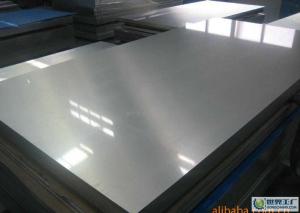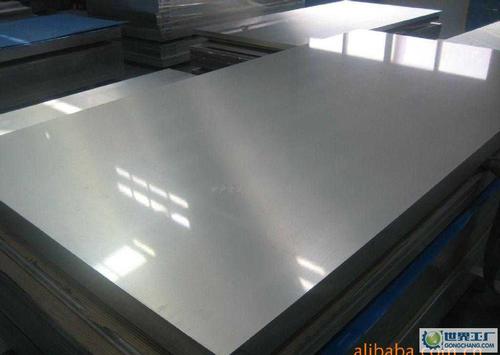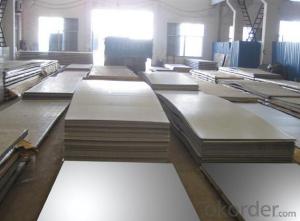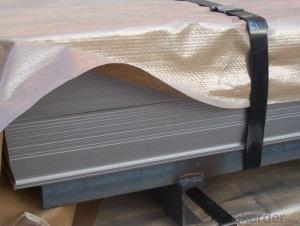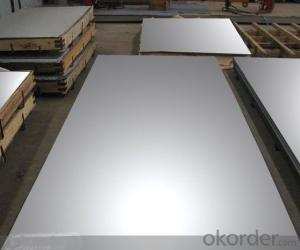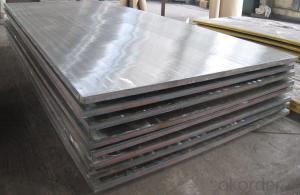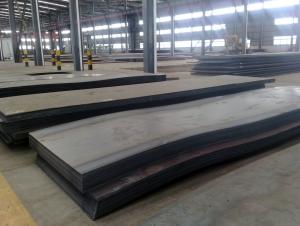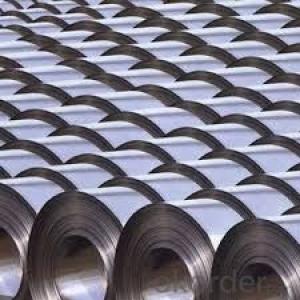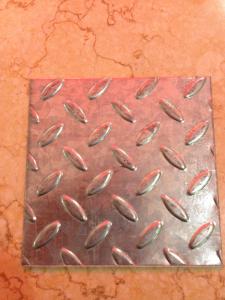stainless steel hot rolled 201
- Loading Port:
- Tianjin
- Payment Terms:
- TT OR LC
- Min Order Qty:
- -
- Supply Capability:
- 5000 m.t./month
OKorder Service Pledge
Quality Product, Order Online Tracking, Timely Delivery
OKorder Financial Service
Credit Rating, Credit Services, Credit Purchasing
You Might Also Like
grade | 201,301,304,310,316,410,420,430,etc. |
surface | 2B,NO.1, NO.4, Mirror, Hairline, etc. |
thickness | 1MM, |
width | 1200MM,1220MM,1500MM,ETC. |
length | 2400MM,2440MM,3000MM,ETC. |
Payment terms | T/T, or L/C. |
Delivery time | Normally within 1 weeks after get your deposits. |
package | Standard export package, normally with wooden pallets |
MOQ | 5 tons/each size |
Our stainless steel sheet have different grades and surfaces,
we have some stocks in warehouse, so , our delivery time is very short.
- Q: What are the benefits of using textured stainless steel sheets?
- There are several benefits to using textured stainless steel sheets. Firstly, the textured surface of these sheets provides enhanced visual appeal and aesthetic value. The unique patterns and textures on the stainless steel sheets can add depth and dimension to any space, making it more visually interesting and appealing. This makes them a popular choice for architectural and interior design projects. Secondly, textured stainless steel sheets offer improved durability and resistance to wear and tear. The textured surface helps to hide scratches, fingerprints, and other imperfections that may occur over time, making the sheets look cleaner and more polished for longer periods. This makes them ideal for high-traffic areas or applications where aesthetics and durability are equally important. Additionally, using textured stainless steel sheets can provide better grip and traction. The raised patterns on the surface of the sheets can create a non-slip surface, making them suitable for applications where slip resistance is crucial, such as flooring, stairs, or ramps. This enhanced grip can also be advantageous in industrial or commercial settings where safety is a priority. Moreover, textured stainless steel sheets are relatively low-maintenance. The textured surface is less prone to showing dirt or smudges, which means less frequent cleaning or maintenance is required. This makes them a convenient choice for applications in busy environments or areas where regular cleaning may be challenging. Lastly, textured stainless steel sheets are highly versatile and can be used in a wide range of applications. From architectural and interior design projects to industrial and commercial settings, these sheets can be employed in various ways. They can be used for wall cladding, columns, decorative panels, countertops, furniture, and much more, offering endless possibilities for creative and functional design solutions. In summary, the benefits of using textured stainless steel sheets include enhanced visual appeal, improved durability, better grip and traction, low-maintenance requirements, and versatility in application. These sheets offer a combination of practical and aesthetic advantages, making them a popular choice for a variety of projects in different industries.
- Q: What are the different types of etched finishes available for stainless steel sheets?
- There are several different types of etched finishes available for stainless steel sheets, each providing a unique and distinctive appearance. Some of the most common etched finishes include: 1. Brushed Finish: This is a popular etched finish that creates a uniform and linear texture on the surface of the stainless steel sheet. It is achieved by brushing the sheet with a fine abrasive material, resulting in a smooth and satin-like appearance. 2. Bead Blasted Finish: In this etched finish, small glass or ceramic beads are blasted onto the surface of the stainless steel sheet at high pressure. This process creates a non-directional and uniform texture, giving the sheet a matte and slightly rough appearance. 3. Mirror Finish: Also known as a No. 8 finish, this etched finish creates a highly reflective and mirror-like surface on the stainless steel sheet. It is achieved through a series of grinding, buffing, and polishing processes, resulting in a flawless and shiny appearance. 4. Satin Finish: This etched finish is similar to a brushed finish but has a finer and smoother texture. It is achieved by using a finer abrasive material during the brushing process, resulting in a soft and elegant appearance. 5. Patterned Finish: This etched finish involves creating various patterns or designs on the surface of the stainless steel sheet. It can be achieved through techniques such as laser etching, chemical etching, or embossing, allowing for a wide range of creative and customizable options. These different etched finishes offer a variety of aesthetic choices for stainless steel sheets, allowing them to be used in various architectural, decorative, and industrial applications. The choice of finish depends on the desired appearance, functionality, and intended use of the stainless steel sheet.
- Q: Are stainless steel sheets resistant to abrasion?
- Stainless steel sheets, in general, exhibit resistance to abrasion. The notable strength and durability of stainless steel make it less susceptible to scratches and wear in comparison to alternative materials. Its smooth surface can endure friction and abrasion, rendering it suitable across diverse applications that necessitate resistance against scratches and wear. Nonetheless, it is crucial to acknowledge that the degree of resistance may differ depending on the specific grade and finish of the stainless steel employed.
- Q: What are the different surface finishes available for stainless steel sheets?
- Stainless steel sheets come in a variety of surface finishes, each with its own unique characteristics and aesthetics. Let's explore some of the options available: 1. The No.1 Finish is the most commonly used finish for stainless steel sheets. It has a rough and dull appearance with visible grain lines. This finish is achieved through hot rolling and is suitable for applications where a rough finish is acceptable. 2. For a smooth and slightly dull surface, the No.2B Finish is ideal. It is obtained by cold rolling and annealing the stainless steel. This finish is commonly used for kitchen appliances, architectural accents, and decorative purposes. 3. Similar to the No.2B Finish, the No.2D Finish also involves cold rolling and annealing. However, it has a smoother and shinier appearance, making it suitable for applications that require a more polished look. 4. The No.3 Finish, also known as a brushed finish, is achieved by polishing the stainless steel with abrasive belts or brushes. It creates a unidirectional satin-like appearance, often used for decorative purposes in architecture and interior design. 5. If you desire a more refined and smoother appearance, the No.4 Finish is the way to go. This finish is obtained by polishing the stainless steel with finer abrasive belts or brushes than the No.3 Finish. It is commonly used for decorative purposes, such as elevator panels, kitchen equipment, and automotive trim. 6. For a highly reflective surface, the No.8 Finish, also known as a mirror finish, is perfect. This finish is achieved by continuously polishing the stainless steel with finer abrasive materials until a glossy, mirror-like appearance is obtained. It is ideal for architectural and decorative applications. 7. The Hairline Finish is achieved by mechanically polishing the stainless steel surface with a fine abrasive material. It creates a subtle, linear pattern with a matte appearance, commonly used for architectural accents, appliances, and decorative items. These are just some of the most common surface finishes available for stainless steel sheets. The choice of finish will depend on the desired aesthetics, functionality, and application requirements.
- Q: Are stainless steel sheets suitable for cryogenic storage tanks?
- Yes, stainless steel sheets are suitable for cryogenic storage tanks. Stainless steel is known for its excellent corrosion resistance, which makes it highly suitable for storing low-temperature substances such as liquefied natural gas (LNG), liquid nitrogen, or liquid oxygen. Cryogenic storage tanks require materials that can withstand extreme low temperatures without becoming brittle or losing their strength, and stainless steel meets these requirements. Additionally, stainless steel has good thermal conductivity, which helps in maintaining the desired temperature inside the tank. It is also easy to clean and maintain, making it a preferred choice for cryogenic storage tanks in various industries.
- Q: Are stainless steel sheets suitable for chemical processing plants?
- Yes, stainless steel sheets are highly suitable for chemical processing plants. Stainless steel is known for its excellent corrosion resistance, making it ideal for handling various chemicals and corrosive substances commonly found in chemical processing plants. Additionally, stainless steel sheets are also durable, hygienic, and easy to clean, making them a reliable choice for maintaining a clean and safe working environment in such facilities.
- Q: How do you prevent staining on stainless steel sheets?
- To prevent staining on stainless steel sheets, there are several measures you can take: 1. Regular cleaning: Clean the stainless steel sheets regularly using mild soap or detergent and warm water. Avoid using harsh chemicals or abrasive cleaners that can damage the surface. 2. Avoid exposure to corrosive substances: Keep stainless steel sheets away from corrosive substances such as bleach, ammonia, and acidic cleaners. If accidental spills occur, immediately rinse the affected area with water and thoroughly dry it. 3. Use a protective coating: Apply a protective coating or film on the stainless steel sheets to create a barrier between the surface and potential staining agents. There are various protective products available specifically designed for stainless steel, such as protective sprays or polishes. 4. Proper maintenance: Regularly inspect the stainless steel sheets for any signs of damage, scratches, or rust. Promptly address any issues by cleaning or repairing the affected areas to prevent staining. 5. Avoid abrasive materials: When cleaning or maintaining stainless steel sheets, use soft cloths or non-abrasive sponges to avoid scratching the surface. Avoid using steel wool or abrasive materials that can leave marks or damage the stainless steel. 6. Dry thoroughly: After cleaning the stainless steel sheets, ensure they are thoroughly dried to prevent water spots or mineral deposits from forming. Use a clean, lint-free cloth to wipe away any moisture. 7. Handle with care: Be mindful of how you handle stainless steel sheets to prevent scratching or damaging the surface. Avoid dragging or sliding heavy objects across the sheets, as this can leave marks or cause abrasions. By following these preventive measures, you can maintain the appearance and integrity of stainless steel sheets and minimize the risk of staining.
- Q: How do you prevent galvanic corrosion when using stainless steel sheets?
- To avoid galvanic corrosion when utilizing stainless steel sheets, there are several precautions you can take: 1. Steer clear of direct contact with dissimilar metals: Galvanic corrosion arises when two different metals make contact in the presence of an electrolyte, such as moisture. To prevent this, ensure that stainless steel sheets do not come into direct contact with dissimilar metals, particularly those with a higher anodic index, such as aluminum or copper. If contact cannot be avoided, utilize insulating materials like plastic or rubber gaskets to separate the metals. 2. Choose compatible fasteners: When securing stainless steel sheets, it is essential to select fasteners crafted from the same or compatible metals. The utilization of dissimilar metals can form galvanic cells, resulting in corrosion. It is recommended to use stainless steel fasteners or those composed of materials with similar corrosion resistance, such as galvanized steel. 3. Apply protective coatings: The application of protective coatings on stainless steel sheets can serve as an additional barrier against galvanic corrosion. Consider utilizing paint, epoxy, or other suitable coatings that are compatible with stainless steel. These coatings act as sacrificial layers, preventing direct contact between the stainless steel and the surrounding environment. 4. Insulate electrical connections: If stainless steel sheets are involved in electrical systems, ensure adequate insulation of electrical connections. This prevents the flow of electrical current between dissimilar metals, reducing the risk of galvanic corrosion. Insulating materials like plastic or rubber sleeves can be employed to separate the metals and impede the formation of galvanic cells. 5. Regulate environmental factors: Galvanic corrosion is often accelerated in the presence of moisture, saltwater, or acidic environments. Controlling these factors can help prevent corrosion on stainless steel sheets. Routinely clean and dry the sheets, particularly in areas where moisture accumulates. Avoid exposing the sheets to saltwater or corrosive chemicals, and maintain proper ventilation to minimize humidity levels. By implementing these preventive measures, you can significantly diminish the likelihood of galvanic corrosion when using stainless steel sheets. However, it is crucial to regularly inspect the sheets for any indications of corrosion and promptly address them to uphold their integrity and longevity.
- Q: Stainless steel drawing plate, polishing plate, mirror panels of the three differences
- From the difference, the stainless steel wire drawing board is a long line, as it is covered with stainless steel plate. The polishing plate refers to a stainless steel plate with a certain brightness. The stainless steel mirror panels can be collectively referred to as glass like stainless steel mirror panels.
- Q: Can stainless steel plate spray paint?
- Basic treatment, in the future, the film can not be solid, the first process is to first clean the stainless steel surface. The treatment method can use the tool to root out the original paint, and also use sandpaper to polish the surface. It is better to use sand blasting to make the surface clean after roughening, and to increase the adhesion area of the primer.
Send your message to us
stainless steel hot rolled 201
- Loading Port:
- Tianjin
- Payment Terms:
- TT OR LC
- Min Order Qty:
- -
- Supply Capability:
- 5000 m.t./month
OKorder Service Pledge
Quality Product, Order Online Tracking, Timely Delivery
OKorder Financial Service
Credit Rating, Credit Services, Credit Purchasing
Similar products
Hot products
Hot Searches
Related keywords
